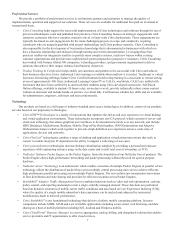Citrix 2013 Annual Report Download - page 21
Download and view the complete annual report
Please find page 21 of the 2013 Citrix annual report below. You can navigate through the pages in the report by either clicking on the pages listed below, or by using the keyword search tool below to find specific information within the annual report.17
• new competitive product releases and updates to existing products;
• industry trend to focus on the delivery of applications especially on mobile devices;
• introduction of potential disruptive technology by third parties;
• termination of our product offerings and enhancements;
• potential market saturation;
• technological change;
• general economic conditions;
• complexities and cost in implementation;
• failure to deliver satisfactory technical support;
• dissatisfied customers; or
• lack of success of entities with which we have a technology relationship.
In addition, there continues to be an increase to the number of alternatives to Windows operating system powered
desktops, in particular mobile devices such as smartphones and tablet computers. Users may increasingly turn to these devices
to perform functions that would have been traditionally performed by desktops and laptops, which in turn may reduce the
market for our Desktop and Application Virtualization products.
If our customers do not continue to purchase our Desktop and Application Virtualization products as a result of these or
other factors, our revenue would decrease and our results of operations and financial condition would be adversely affected. In
addition, modification or termination of certain of our Desktop and Application Virtualization products may cause variability in
our revenue and make it difficult to predict our revenue growth and trends in our Desktop and Application Virtualization
products as our customers adjust their purchasing decisions in response to such events.
Industry consolidation may result in increased competition.
There has been a trend toward industry consolidation in our markets for several years. We expect this trend to continue as
companies attempt to strengthen or hold their market positions in an evolving industry and as companies are acquired or are
unable to continue operations. For example, some of our competitors have made acquisitions or entered into partnerships or
other strategic relationships to offer a more comprehensive solution than they had previously offered. Additionally, as IT
companies attempt to strengthen or maintain their market positions in the evolving desktop and application virtualization,
collaboration and data sharing, mobility, cloud networking and cloud platform markets, these companies continue to seek to
deliver comprehensive IT solutions to end users and combine enterprise-level hardware and software solutions that may
compete with our virtualization, mobility and collaboration and data sharing solutions. These consolidators or potential
consolidators may have significantly greater financial, technical and other resources than we do and may be better positioned to
acquire and offer complementary products and services. The companies resulting from these possible combinations may create
more compelling product and service offerings and be able to offer greater pricing flexibility or sales and marketing support for
such offerings than we can. These heightened competitive pressures could result in a loss of customers or a reduction in our
revenues or revenue growth rates, all of which could adversely affect our business, results of operations and financial condition.
Actual or perceived security vulnerabilities in our products and services or cyberattacks on our networks could have a
material adverse impact on our business and results of operations.
Use of our products and services may involve the transmission and/or storage of data, including in certain instances
customers' business and personally identifiable information. Thus, maintaining the security of products, computer networks and
data storage resources is important as security breaches could result in product or service vulnerabilities and loss of and/or
unauthorized access to confidential information. We devote significant resources to addressing security vulnerabilities in our
products and services through our efforts to engineer more secure products and services, enhance security and reliability
features in our products and services, deploy security updates to address security vulnerabilities and seeking to respond to
known security incidents in sufficient time to minimize any potential adverse impact. Despite our preventive efforts, last year
unauthorized parties have penetrated certain of our systems leading to the revocation of a code signing certificate in August
2013. Generally speaking, unauthorized parties may attempt to misappropriate or compromise our confidential information or
that of third parties, create system disruptions, product or service vulnerabilities or cause shutdowns. These perpetrators of
cyberattacks also may be able to develop and deploy viruses, worms, malware and other malicious software programs that
attack our products and services, our networks or otherwise exploit any security vulnerabilities of our products, services and
networks. Because techniques used by these perpetrators to obtain unauthorized access to or sabotage systems change
frequently and generally are not recognized until long after being launched against a target, we may be unable to anticipate
these techniques or to implement adequate preventative measures. We can make no assurance that we will be able to detect,
prevent, timely and adequately address, or mitigate the negative effects of cyberattacks or other security breaches.
A breach of our security measures as a result of third-party action, malware, employee error, malfeasance or otherwise
could result in (among other consequences):
























